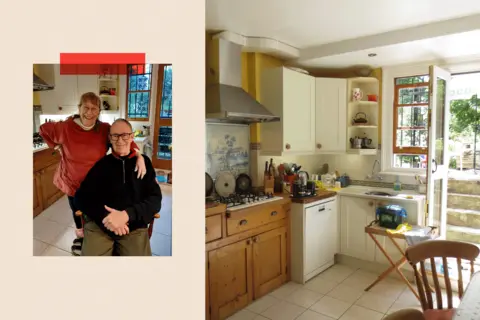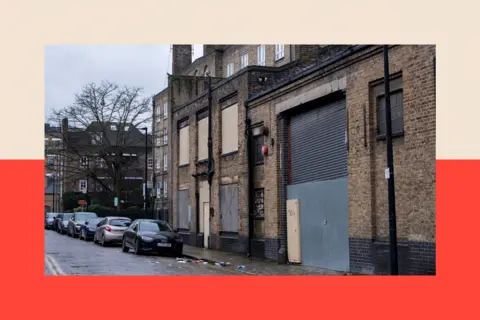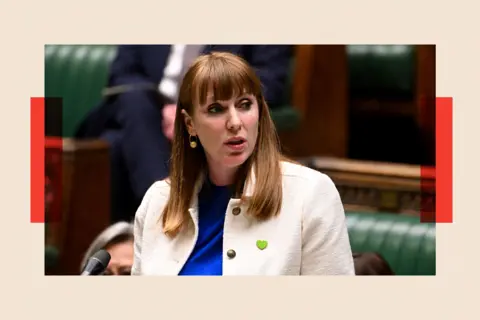
 BBC
BBCIn 1980, when Corina Poore, 36 years old and pregnant, first opened the door to a derelict house in New Cross Gate, south-east London, the estate agent refused to step in with her.
Inside were dead cats, dog excrement and filthy mattresses. Pigeons flew in through holes in the roof and there was no indoor toilet. The intense rotting smell was overwhelming.
Still, Corina decided this was her dream home. It was spacious, the £24,000 price was affordable and she was sure that everything was fixable.
After taking out a mortgage, she received a grant of £3,500 from Lewisham council, her local authority, which paid for fixing the ceiling.
“At that point, £3,500 was quite a healthy amount, which I desperately needed,” recalls Corina.

Some 45 years on, her Victorian four-storey house is worth roughly £1m – something Corina, a semi-retired film and TV critic, could never have afforded otherwise.
However, times have changed.
Lewisham Council has continued to offer grants to the owners of empty homes for improvements – some for as much as £20,000 – but the uptake is low.
Just 22 grants were awarded in the borough in the last five years – despite it having 2,253 empty homes. A spokesperson for Lewisham Council said that, in addition to the grants, it is working “to make sure homes aren’t allowed to remain empty or become derelict in our borough”.
At present, however, 775 have been empty for longer than six months. Meanwhile, there is a national housing shortage, with rising homelessness and long social housing waiting lists.
As of October 2024, there were almost 720,000 empty homes in England, according to the government.
 Mike Kemp/In Pictures via Getty Images
Mike Kemp/In Pictures via Getty ImagesOn the face of it, bringing these empty properties back into use would make up a significant chunk of the 1.5m homes that the Labour government wants to add to the country’s housing stock by the end of its term.
But so far that isn’t happening enough. The question is why, and given it could, in theory, be a sensible solution to two growing problems, is this a case of a missed opportunity – or is the issue more complex still?
Rising long-term empty homes
Not all empty homes are in the dire state of repair that Corina’s once was. But roughly 265,000 of them in England have been vacant for longer than six months and are classified by the government as long-term empty (LTE). (Wales, Scotland and Northern Ireland have different housing policies, as housing is a devolved matter in the UK.)
Fixing these would also have a significant effect on the communities around them, as long-term empty properties can attract anti-social behaviour and in some cases reduce an area’s value.
Ann Devereaux, of St Werburgh’s in Bristol, says that after the property next to her home fell vacant, it became a “magnet” for crime.
“It makes me feel scared when I leave my house or come in at night,” she added.

The government has previously stepped in. The 2010-15 Coalition made funding available via two schemes: the Empty Homes Programme, which gave owners grants to fix their long-term empty homes; and the New Homes Bonus scheme, which rewarded councils that brought such properties back into use.
They appeared to have made an impact. Between 2010 and 2016, the overall number of empty homes dropped by 20% to 590,000, and crucially, long-term empty homes dropped by 33% to 200,000.
However, in 2016 the government then ended the Empty Homes Programme and lowered the rewards from the New Homes Bonus scheme – after which the issue became the sole responsibility of councils.
By 2024, the number of empty homes had crept back up by 22% and the number of LTEs had risen 32%.
A report by the charity Action on Empty Homes concluded it was “likely” that the end of the Coalition’s scheme had been a factor behind this increase, alongside changing housing market conditions and economic uncertainty.
And once it was left up to local authorities to decide what to do about empty homes, the approach varied widely from place to place.
Councils got creative – but struggled to solve it
Currently there is no centralised information about the actions individual English councils have taken since 2016, so we contacted each one to ask about their approach.
In total, 77 of the 245 councils who responded to the BBC’s freedom of information requests said they continued providing grants or loans. But in most cases, take-up was so low that it didn’t prevent the number of long-term empty homes from rising.
A few councils even ended their financial assistance schemes because of this.
Corina Poore suggests that people may not realise such schemes even exist.
But Benjamin Radstone, a property developer who partners with the public to identify empty homes, says there is a range of reasons why owners don’t take up offers and incentives around empty homes.
“People don’t want to be pressured,” he says. “They’ll do it when they’re ready to do it.”
Other councils have had some success with schemes of their own. In Kent, a No Use Empty scheme offers interest-free loans for up to three years to owners who will let or sell the property afterwards.
Though it was set up 20 years ago with a relatively modest pot of £5m, today it is self-sustaining. Nearly 200 of these loans have been issued over the past five years.
Now the council wants to see the scheme expanded nationally. Last year a group of MPs, peers and housing campaigners wrote to housing minister Matthew Pennycook urging him to implement it nationwide.
Elsewhere in England, some councils have tried more creative solutions, such as connecting private investors with empty homeowners. Almost all councils charge premium council tax rates on long-term empty homes, which can be as much as 300% of standard council tax rates.
But Mr Radstone, who refurbishes empty homes through his company You Spot Property, argues, that this can “push people away from wanting to engage with the council”.
Some also argue that this can disincentive councils from addressing the root problem, as empty homes bring them more income through the premium tax rates.
“We’re now in a position where councils are actually saying, ‘Well, we’re being rewarded for homes being left empty longer,'” says Adam Cliff, policy lead at the Empty Homes Network.

Councils do also have the power to take legal action against owners of empty homes, but this can be risky, time-consuming and costly.
And while loans and grants can be used to target about 10-20% of long-term empty homes, Mr Cliff estimates, you would need to make use of other processes to get the majority of them back into use, he says.
This was the experience of Kent County Council, which says only 18% of its LTEs that were brought back into use did so after interest-free loans were issued. In fact 61% did so after advice was offered to owners around the likes of tax and VAT, raising finance and planning.
“If a council has 2,000 empty homes,” Mr Cliff says, “they need 2,000 different solutions.”
A baffling conundrum
Part of the conundrum about there being a quarter of a million long-term empty homes is that this comes at a time when at least 354,000 people in England are believed to be homeless, and 1.33m households are on social housing waiting lists.
This is also a time when renters and buyers alike talk about a housing crisis in which soaring costs leave properties out of reach.
The Office for National Statistics’ definition of affordability is homes selling for less than five times local earnings – which has not been the case on average nationally since 2002.
More homes on the market would help tackle this, too. So why has more not been done to solve, or at least better address, this contradiction?

The challenge is that there is no single reason for homes being empty.
One factor is the probate system, which can in some cases take several years, during which time the deceased person’s house cannot be sold. Katie Watson from probate research firm Finders International, believes increasing staff numbers could help address a court backlog.
Then there is the issue that sometimes, councils are unable to track down the owners of empty homes. Jasmine Basran, head of policy and campaigns at homeless charity Crisis, believes there is a “lack of coherent data”.
When the BBC approached English councils, the information we were provided about the condition and reason for homes being empty covered only around 13% of their LTE stock.
This means councils are “blind to their potential”, argues Ms Basran.
The debate around premium tax rates
The experts we spoke to had their own view on the best solutions. For Mr Radstone, it is through offering tax relief to buyers, as well as ensuring that everyone who takes out a mortgage keeps an up-to-date will to prevent probate hold-ups.
Mr Grimshaw, meanwhile, argues that the funds gathered from the premium tax rates could be used by councils to start their own loan schemes.
But Mr Cliff argues councils without an empty homes strategy should not be allowed to charge premiums.
One thing most of those I spoke to were unanimous on, however, was that the government should establish a statutory duty for councils to address long-term empty homes – and force them to investigate and act.
The former Conservative government didn’t introduce this – although in March 2024 it did allow councils to double council tax on empty properties after 12 months rather than two years.
 House of Commons/Handout via REUTERS
House of Commons/Handout via REUTERSThis was part of a “long-term plan for housing” to “help give local people the homes they need”, then local government minister Simon Hoare said at the time.
We are yet to see if the new Labour government has taken the suggestion of a statutory duty on board in its housing strategy, although Housing Secretary Angela Rayner has said councils will be given more power to force landlords to rent out empty homes.
Meanwhile a spokesperson for the Ministry of Housing, Communities and Local Government said: “We are determined to fix the housing crisis we have inherited, and we know that having too many empty homes in an area can have a significant impact on local communities.
“That’s why councils have strong powers to increase council tax on LTEs, and we will strengthen councils’ powers to take over the management of empty homes, with further updates to be provided in due course.”
Back in south-east London, Corina Poore doesn’t fully understand why the scheme that worked so well for her – and allowed her to become the homeowner of a £1m property – isn’t doing the same today.
She believes it could still be a way of getting young people to make empty homes habitable too.
“When you’re young you can do these things,” says Corina, who got in touch through My Voice, My BBC. “[There are] people out there who would be prepared to do it.
“There are lots of houses that are nowhere near as bad as mine that probably just need a kitchen and a bathroom, and I think it should still be encouraged very vigorously.”
BBC InDepth is the home on the website and app for the best analysis, with fresh perspectives that challenge assumptions and deep reporting on the biggest issues of the day. And we showcase thought-provoking content from across BBC Sounds and iPlayer too. You can send us your feedback on the InDepth section by clicking on the button below.






